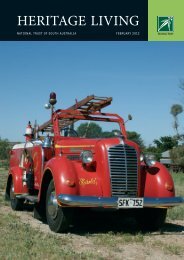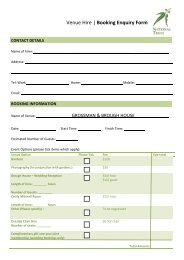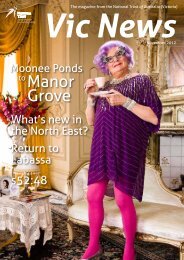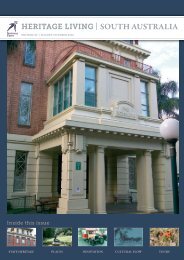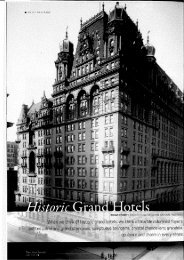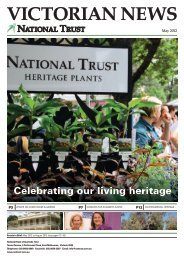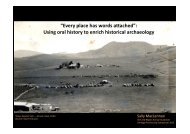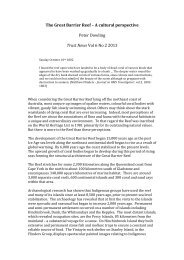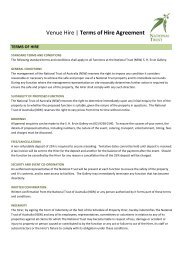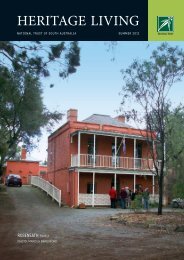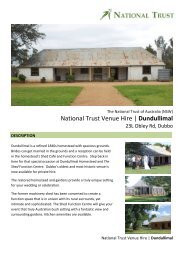Heritage Living Winter 2011 - National Trust of Australia
Heritage Living Winter 2011 - National Trust of Australia
Heritage Living Winter 2011 - National Trust of Australia
Create successful ePaper yourself
Turn your PDF publications into a flip-book with our unique Google optimized e-Paper software.
<strong>Heritage</strong> <strong>Living</strong>national TRust <strong>of</strong> South <strong>Australia</strong>Adaptive re-use makes for sometruly interesting contemporary spaces Marcus BeresfordAbove: Hardy MilazzoPhoto: Marcus BeresfordAbove: Hardy MilazzoPhoto: Marcus BeresfordVisitors walk through the 19 th century doorway<strong>of</strong> 44 Currie St into an utterly contemporaryspace, with a glass and steel lift-well to the leftand glass stair-well to the right. Ahead is a slightlyraised floor <strong>of</strong> modern <strong>of</strong>fices, which neverthelessechoes the traditional few steps up into a 19 thcentury warehouse building.The conversion <strong>of</strong> what was originally Bickford’sCordial Factory by Hardy Milazzo Architects is astand-out example <strong>of</strong> how to adapt an old buildingto meet modern access, safety, fire and otherrequirements, but retain a record <strong>of</strong> great interest,and create a pleasant working environment.The architects’ <strong>of</strong>fices on the second floor, inparticular, illustrate a sensitivity to earlier uses,with the foundation <strong>of</strong> an earlier brick wallpreserved under clear resin on the floor in front<strong>of</strong> the reception counter, exposed internal brickwalls with fine wide archways dividing up spaces,and even colour highlights suggestive <strong>of</strong> Bickford’slime and sarsaparilla cordials! Exposed woodenceiling rafters and purlins, an intriguing maze <strong>of</strong>steel air-conditioning ducts and a modern ro<strong>of</strong>topfloor not visible from street level, add to theattractive but functional <strong>of</strong>fice spaces.Bickford’s Buildings were designed by DanielGarlick in 1878 and comprise three joinedwarehouses <strong>of</strong> Mitcham freestone with Italianatedressings. Bickford’s also produced “Cough Elixir,Dandelion, Quinine and Liver Pills, Cream <strong>of</strong> Liliesfor the Complexion, Rosaline for teeth and breath,Hair Dye, Bonbons or Worm tablets for children”.The buildings later became the Anglican ChurchOffices.Architects Graham Hardy and Darren Park say theadaptation <strong>of</strong> the building was on the one handfacilitated by relative freedom to deal with interiorspaces (which had already been heavily modifiedin the 1950s), but on the other hand the architectspushed the owners to retain many features thatmight otherwise have been gutted.Around the corner in Leigh Street is a group <strong>of</strong>further 19 th century buildings adapted to newuses or handsomely restored to their formerappearance - the SA Archives (formerly Megaw &Hogg Auction Rooms) at 26-30 Leigh St, designedfor Bickford’s by the same architectural firm in1895; and the original Anglican Church <strong>of</strong>fice <strong>of</strong>1861 at number 18, with its upper floor <strong>of</strong> 1877-8designed by William McMinn.To mark the inaugural <strong>National</strong> <strong>Heritage</strong> Week14-20 April <strong>2011</strong> the Adelaide and Inner SuburbsBranch <strong>of</strong> the NTSA arranged a short noticetour <strong>of</strong> these and other city buildings adaptedfor re-use, led by Adelaide City Councillor SandyWilkinson.Also visited were the nearby Miller Apartmentsat 15 Hindley St, formerly Miller AndersonDepartment Store (begun as William Sanders andJohn Whyte linen merchants in the earlypage 8
<strong>Heritage</strong> <strong>Living</strong>national TRust <strong>of</strong> South <strong>Australia</strong>trust newsWilabalangaloo: ‘Place <strong>of</strong> red, yellow and brown stones’glenn Williams Natural <strong>Heritage</strong> ManagerAbove: Wilabalangaloo CliffsPhoto: Dean Linesseven-kilometre riverboat journey upstreamA from the Riverland township <strong>of</strong> Berri is thecaptivating natural setting <strong>of</strong> Wilabalangaloo. The94 hectare property is shouldered by the RiverMurray to the east and dissected by the Old SturtHighway to the west.Wilabalangaloo <strong>of</strong>fers scenic views and spectacularochre-coloured limestone cliffs along itskilometre-long river frontage. Featuring stunningexamples <strong>of</strong> the region’s geological and naturalhistory and early aboriginal habitation, the nameWilabalangaloo is thought to be derived from anAboriginal word meaning ‘the place <strong>of</strong> red, yellowand brown stones’ a link to the colours in the cliffs.At the time <strong>of</strong> white settlement and pastoralleases, this property was just a postage stamppiece <strong>of</strong> the enormous Cobdogla Station, land thathad been taken up as a sheep run in 1842 and part<strong>of</strong> the Chambers brothers’ empire. (CobdoglaStation once stretched from Overland Corner toLake Victoria inside the New South Wales border,covering some 500kms <strong>of</strong> river frontage).In 1908 Cobdogla Station was resumed by theCrown for irrigation settlement (the Berri andCobdogla Irrigation Areas). The designation<strong>of</strong> Irrigation Perpetual Leases increasedpace with the influx <strong>of</strong> returned soldiersand the decision to include Berri aspart <strong>of</strong> Soldier Settlement.Left: <strong>National</strong> <strong>Trust</strong> plaque atWilabalangaloo in 1959Photos: NTSAAbove left: Janet Reiners (shovel in hand)and members <strong>of</strong> the Renmark Branch erect the<strong>National</strong> <strong>Trust</strong> plaques at Wilabalangaloo in 1959Photos: NTSAAbove right: Janet Reiners Photos: NTSAThe Legacy <strong>of</strong> Janet Annie Reiners 1Janet Annie Reiners was born at Renmark on 24thFebruary, 1895. From an early age Janet was veryactive, fit, a lover <strong>of</strong> animals, natural beauty andopen spaces.During the 1930s, travelling regularly onhorseback or driving a sulky to Loxton via Berrior Paringa (to help with her father’s buildingventures) Janet had been able to explore andfall in love with the Wilabalangaloo environs.Later, with her heart set on the notion, she wassuccessful in purchasing the property in 1941.The red and yellow sandstone used for thebuilding <strong>of</strong> her home on the property in 1942,was quarried from the eastern frontage <strong>of</strong>Wilabalangaloo.In 1957, owing to the strong relationship shehad with members <strong>of</strong> the Renmark <strong>National</strong><strong>Trust</strong> Branch, Janet resolved to gift the southernportion <strong>of</strong> her property as a <strong>National</strong> <strong>Trust</strong>Reserve, formally gazetted in March 1959.Following the early years <strong>of</strong> the Berri Branch <strong>of</strong>the <strong>National</strong> <strong>Trust</strong> (formed in 1963) Janet haddecided to give all her remaining land to the1 Information extracted from The History <strong>of</strong> Wilabalangaloo,compiled by the late DB Mack on behalf <strong>of</strong> the Berri Branch <strong>of</strong>the <strong>National</strong> <strong>Trust</strong> <strong>of</strong> South <strong>Australia</strong>, September 1983page 10
<strong>Heritage</strong> <strong>Living</strong>national TRust <strong>of</strong> South <strong>Australia</strong>trust news<strong>National</strong> <strong>Trust</strong>, as an organisat ion which wouldensure that her property would remain in safehands in perpetuity.Dedication <strong>of</strong> the remaining portions <strong>of</strong> her landas part <strong>of</strong> the Reserve were published in theGovernment Gazette <strong>of</strong> 18th May, 1972. Janet wasmade an Honorary Life Member <strong>of</strong> the <strong>National</strong><strong>Trust</strong> <strong>of</strong> South <strong>Australia</strong> in recognition <strong>of</strong> her gifts.As agreed at the time <strong>of</strong> her original gift to the<strong>Trust</strong> in 1957, Janet had life-time occupationrights without charge to her, as well as over-ridingsay in relation to the house and property. Janetretired from the property on 29th August, 1977, toWaterford Private Hospital, Glenelg. She died onthe 18th February 1990.The Nature ReserveThe constant and enduring feature <strong>of</strong>Wilabalangaloo is its natural landscape and floraand fauna conservation values. The days <strong>of</strong> amuseum and exhibits depicting early Riverlandlife are now over; as are the wildlife enclosuresand animals that featured as part <strong>of</strong> past visitorattractions.During the mid-1970s to the early-1990s, theBerri Branch had created and modified a series<strong>of</strong> interpretive walking trails. Building on thatthe most recent redevelopment (courtesy <strong>of</strong> aphilanthropic grant) was completed in mid-<strong>2011</strong>.Over the past two years, groups <strong>of</strong> local, interstateand international volunteers have carved out newtrail sections and installed new signs, markerposts and fencing, for a better visitor experience.Supported by a new self-guided tour brochure,the trail network provides an up-close-andpersonalexperience <strong>of</strong> scenic riverine landscapes,fascinating geology and a recovering malleehabitat supporting remarkable vegetation andwildlife.The nature trail is now a core element <strong>of</strong> theWilabalangaloo Nature Reserve.Contributing to the regional story about pre-European heritage and post-settlement influenceson the riverine environment, Wilabalangaloonow also features as part <strong>of</strong> the <strong>National</strong><strong>Trust</strong>’s Riverland <strong>Heritage</strong> Trail (as identified in apromotional booklet published April 2010).Mary Martin Bookshop & Café, former Norwood BaptistChurch 1870ACTIVATINGOUR BUILT HERITAGEA seminar in conjunction with the Don DunstanFoundation on building re-use in SA andpromoting development with heritage.Wednesday 5 October <strong>2011</strong>, 6-00pm,Mary Martin Bookshop & Café134A Norwood Parade, NorwoodThis exciting event will feature the dynamic SteffenLehmann, author and Pr<strong>of</strong>essor <strong>of</strong> SustainableDesign at the University <strong>of</strong> SA, and an expert panelwith audience discussion about adaptive re-useand future directions for built heritage. Venue willbe the airy space <strong>of</strong> the former Baptist Church1870, now superbly re-configured as bookshopand café.The NTSA will also launch its Cultural <strong>Heritage</strong>Advisory Committee’s discussion paper <strong>Living</strong><strong>Heritage</strong> Vision 175, on creating a richer morediverse and sustainable built environment topromote SA as The <strong>Heritage</strong> State.6-00pm6-25pm6-30pm7-00pmProgram:Drinks, tea or c<strong>of</strong>feeWelcome and launch <strong>Living</strong> <strong>Heritage</strong>Vision 175 by David BeaumontNTSA PresidentKeynote address byPr<strong>of</strong>essor Steffen LehmannPanel and discussionChair: Pr<strong>of</strong>essor Ben HewittSA Government ArchitectPanelists invited include: Paul Leadbeter,Senior Lecturer Adelaide University Law School;Carolyn Wigg, Research Fellow University <strong>of</strong> SA;Dr Ianto Ware, Renew Adelaide (urban renewal <strong>of</strong>empty spaces).Bookings through the <strong>National</strong> <strong>Trust</strong> <strong>of</strong>fice8202 9200 or Don Dunstan Foundation,L4 230 North Tce, Adelaide, tel 8303 3364,www.dunstan.org.au$10 entry (indicate NTSA membership),$5 low income.page 11
<strong>Heritage</strong> <strong>Living</strong>national TRust <strong>of</strong> South <strong>Australia</strong>History <strong>of</strong> the Royal Adelaide HospitalLyn O’GradyThe Royal Adelaide Hospital is expected to movefrom its present site in coming years and thefate <strong>of</strong> existing buildings is uncertain at this stage.Although the Margaret Graham building in FromeRd is State <strong>Heritage</strong> listed, and the Women’sHealth Centre on the North Terrace corner isLocal <strong>Heritage</strong> listed, no other buildings haveany protection. Bice and McEwin buildings wereon the former <strong>Australia</strong>n <strong>Heritage</strong> Commission’s<strong>National</strong> Estate Register, but that only affectedCommonwealth government actions (and wasabolished under the Howard government anyway).The NTSA’s Adelaide and Inner Suburbs Branchis establishing a task force to look at moves toprotect site buildings this year. Meanwhile, it maybe <strong>of</strong> interest to read some <strong>of</strong> the history <strong>of</strong> South<strong>Australia</strong>’s main hospital.The second SA Governor George Gawler firstproposed to use £300 which was at his disposal forcharitable purposes as the nucleus <strong>of</strong> a fund to builda hospital. He invited the public to contribute to thisfund but although Adelaide’s population had risen to8,500, only a further £300 was raised. Gawler wentahead but had to draw bills on England’s Treasury tomeet the cost <strong>of</strong> this and other public works, whicheventually proved his undoing.Work began in 1839 on a site in the parklands tothe north <strong>of</strong> Botanic Road and near Hackney Road.The Governor laid the foundation stone <strong>of</strong> the firstbuilding, to be called the ‘Adelaide Hospital’ on15 July 1840. The residents <strong>of</strong> Adelaide showedas little interest in this function as they had insubscribing to the cost <strong>of</strong> the building but thesmall attendance was charitably attributed to thedistance from the city and the inclement weather.When completed, the building providedaccommodation for 30 patients in three wards, tworooms for staff and a central room which servedas required as front hall, dining room, boardroomor operating theatre. An omission in the plans wasthat there was no kitchen and the Board agreedto provide ‘a small place for wood and culinarymaterials’, but declined to appoint a male cook(who was to also act as handyman) on grounds <strong>of</strong>expense.Above: Margaret Graham Nurses Home Royal Adelaide Hospital Photo: Marcus Beresfordpage 12
<strong>Heritage</strong> <strong>Living</strong>national TRust <strong>of</strong> South <strong>Australia</strong>History <strong>of</strong> the Royal Adelaide HospitalLyn O’GradyIt was hoped that the new Adelaide Hospital wouldmeet the needs <strong>of</strong> the community for many years,but the huge influx <strong>of</strong> emigrants in the 1840s soonmade it inadequate.A second Adelaide Hospital was built on NorthTerrace in 1856. Building work on this newhospital was delayed because <strong>of</strong> the gold rush inVictoria in 1851 with the exodus <strong>of</strong> manpower andrelated withdrawal <strong>of</strong> funds from the banks.Dr William Gosse, as Acting Colonial Surgeon,took charge <strong>of</strong> this new hospital which consisted<strong>of</strong> the central building and west wing. The westwing contained eight wards and the central blocka surgery, dispensary and living quarters for thehouse surgeon. An east wing was built in 1866-67and provided four extra wards, some bedrooms,padded rooms, and a nurses’ dining room (whichalso served as a chapel). Further additions weremade to the central block in 1857 and 1863, whilein 1858 a boiler house, kitchen, drug store andmortuary were built.Anaesthesia was not available to medicalpractice until 1860s. The discovery <strong>of</strong> X-rays in1895 and the continuous advance <strong>of</strong> radiologyand radiotherapy since then have necessitatedthe installation <strong>of</strong> equipment for whichaccommodation has had to be provided. Pathologyhas demanded increasing space and facilities,culminating in the foundation <strong>of</strong> the Institute <strong>of</strong>Medical and Veterinary Science in 1938.By the 1950s there were a total <strong>of</strong> 47 buildings onthe site and an extensive rebuilding <strong>of</strong> the hospitalwas regarded as inevitable. Between 1856 andthe ‘great demolition’ <strong>of</strong> 1963, no building in thehospital had been discarded until the last ounce <strong>of</strong>use had been extracted.The first step would have to be the provision <strong>of</strong>accommodation for patients while the rebuildingtook place. It was decided a new East Wing wouldbe the solution, accommodating the RadiotherapyDepartment and five floors for patients during therebuilding.A series <strong>of</strong> buildings, each with its specialfunction was suggested as this would allowearlier occupation than if one all-inclusive blockwere built. The buildings envisaged were aservices block with administration, casualty andoutpatient and theatre sections; a ward block,the North Wing; and the staff block, later namedthe Nurses’ Residential Wing. It was feared thatany criticism <strong>of</strong> this plan would lead to furtherindefinite postponement <strong>of</strong> the venture and so itwas accepted, with the honorary staff pledgingfull cooperation. The new buildings were occupiedprogressively between 1966 and 1969.No matter whether you believe the hospital shouldbe rebuilt or relocated, it is interesting to note thatmany <strong>of</strong> the present RAH structures were newonly 40-50 years ago.Researched from the internet http://www.rah.sa.gov.au/heritage/hugheshist2.phpBEAUMONT HOUSE GARDENLocation: 631 Glynburn RoadVOLUNTEERS,HISTORICPLANTSAND SLATEWANTED!VolunteersPlease join me andfellow volunteersduring the morning <strong>of</strong>the last Wednesday <strong>of</strong>each month to workin the garden for acouple <strong>of</strong> hours underthe supervision <strong>of</strong> ourqualified gardener, Alex.Tea, c<strong>of</strong>fee and cakewill be provided.Plants:Donations <strong>of</strong> cuttingsfrom hardy historicplants wanted for thegarden. Please notethat due to oversupply,agapanthus are notneeded!SlateLarge pieces <strong>of</strong> greyslate are required asstepping stones. Cananyone please assist?Collection from you canbe arranged.Looking forward tohearing from you.Deborah MorganChair, BeaumontHouse GardenCommitteeIf you can assist with any <strong>of</strong> the aboveplease contact <strong>National</strong> <strong>Trust</strong> <strong>of</strong> SA State Office PH (08) 8202 9200page 13
<strong>Heritage</strong> <strong>Living</strong>national TRust <strong>of</strong> South <strong>Australia</strong>trust newsTouring: literary and SA connections at WilcanniaMarcus BeresfordIn the arid western plains <strong>of</strong>NSW some 965 km west <strong>of</strong>Sydney and 700km east fromAdelaide, is the once thrivingtown <strong>of</strong> Wilcannia, populationAbove: Wilcannia warehouse 760. The Barkindji peoplePhoto: Marcus Beresford now form a majority (54%) <strong>of</strong>its inhabitants, but at its peakWilcannia bustled with over 3000 people and wasthe third largest port on the Murray Darling riversystem. In 1887 as many as 222 paddle-steamersdocked in connection with particularly the wooltrade <strong>of</strong> the region. Resch built his first breweryin the town. By the 1920s, increasing rail and roadtransport and the shift <strong>of</strong> trade to Broken Hill sawa decline set in. Now the streets <strong>of</strong> Wilcannia arefull <strong>of</strong> the romance <strong>of</strong> decay, although the RiverDarling remains a pulse <strong>of</strong> natural life, flowingunder the impressive <strong>National</strong> <strong>Trust</strong> classifiedbridge (1896), with its centre-lift section to allowthe passage <strong>of</strong> taller boats.Left to right: Wilcannia Courthouse, Athenaeum Pioneer Museum, WilcanniaPost Office Photos: Marcus BeresfordThe main street parallel with the river includesthe fine local sandstone Post Office (1880),Athenaeum Museum (1883), Police station andresidence (1881) and Courthouse (1880) in therather classical NSW courthouse-style <strong>of</strong> architectJames Barnet (SA had a more carpenter’s gothiccourthouse-style as exemplified at Goolwa orStrathalbyn). Fascinatingly, this court was thescene <strong>of</strong> an animal cruelty trial on 25 April 1885,involving Police Magistrate Edward Dickens(writer Charles Dickens’s son, who managed MtMurchison station nearby from 1876-1881 and waslater elected NSW MP) and prosecution witnessFrederick Trollope (son <strong>of</strong> novelist AnthonyTrollope).Nearby is a very handsome warehouse (1878)which may have belonged to AH Landseer, amerchant pioneer <strong>of</strong> Milang SA. His companyoperated from 1860 to about 1920 with branchesall along the Murray Darling system includingWilcannia and Morgan SA (where the LocalCouncil-owned AH Landseer warehouse <strong>of</strong> 1878now forms the Morgan <strong>Living</strong> History Museum).Albert Henry Landseer was sometimes knownas the “Duke <strong>of</strong> Milang”, and operated a nowvanished general store, two story warehouse anddwelling, and large flour mill in Milang. In 1873he had a floating dock constructed (reputed tobe the largest in the southern hemisphere) but itwas not a success at Milang and was later movedto Mannum, where it succeeded and is now nearthe location <strong>of</strong> the <strong>National</strong> <strong>Trust</strong> <strong>of</strong> SA restoredpaddle-steamer Marion (also built originally forLandseer in 1897).Other Landseer boats included the P.S. Bourkefor which the log <strong>of</strong> a journey from Morgan toKallara (halfway between Wilcannia and Bourkeon the River Darling) can be viewed in the SAState Mortlock Library. Another Landseer boatwas the 117 ton Dispatch which carried up to 60passengers and the Royal Mail across the lakesfrom Milang to Meningie, a key part <strong>of</strong> an earlyoverland mail route until the 1880s. The Dispatchalso carried a royal visitor across the lakes toCampbell Park homestead on Lake Albert for akangaroo hunt.Landseer was the cousin <strong>of</strong> British animal painterand sculptor Sir Edwin Landseer (1802-73)who modelled the lions at the foot <strong>of</strong> Nelson’scolumn in Trafalgar Square. In an intriguing twist,page 14
<strong>Heritage</strong> <strong>Living</strong>national TRust <strong>of</strong> South <strong>Australia</strong>trust news<strong>Australia</strong>n author Nancy Cato starts her historicalnovel The Lady Lost in Time (about actual 17 thcentury British portrait painter MaryBeale) with her discovery in 1960 <strong>of</strong> aforgotten, damaged portrait attributedto Beale in a decaying old 2 storeywarehouse and dwelling at Milang oncebelonging to a Murray Darling Riversmerchant. Was this AH Landseer’s, orwas it simply some fictional device? ANTSA classified Milang Wool Shed datedc1860 was demolished in 1975.Such musings remind <strong>of</strong> the onceso culturally and economicallyimportant river trade, which the NTSA hopes willbe recognised through its <strong>2011</strong> nomination <strong>of</strong> theMurray Bridge Historic Transport Hub, a key node inthe river, rail and road transport networks focussedaround the River Murray and Lower Lakes.References:Nancy Cato The Lady Lost in Time (Collins Sydney 1986)<strong>Heritage</strong> <strong>of</strong> <strong>Australia</strong> (Macmillan South Melbourne 1981) p2/281<strong>National</strong> <strong>Trust</strong> <strong>of</strong> SA Register <strong>of</strong> Historic Buildings 4 th edn 1980Thorne & Collocott (eds) Chambers Biographical Dictionary(Edinburgh 1990)Websites: www.murrayriver.com.au/paddleboats/river-boattrading-milang/;morgan.org.au/html/museum.html; gabr.net.au/archives/ABEO562a.html; flotilla-australia.com/saother.html#;rivermurrayshop.com.au/Paddlesteamers.html; visitoutbacknsw.com/Wilcannia-nsw.html; smh.com.au/travel; postcards-sa.com; WikipediaEvocative Victor Harbor MuseumMarcus BeresfordThe <strong>National</strong> <strong>Trust</strong> operated Encounter CoastDiscovery Centre, on Flinders Parade VictorHarbor, <strong>of</strong>fers many interesting insights into thehistory <strong>of</strong> the area. It is housed in the originalCustoms House, built in 1866 (using stoneballast from sailing ships). This later became theharbour-master’s and railway station-master’sresidence.A pr<strong>of</strong>essionally constructed display focuses onthe post-European settlement period, althoughthere is a section on the Ngarrindjeri Aborigines.Whaling occurred for a long period beforeformal colonisation and <strong>of</strong> particular interestis the display <strong>of</strong> a twisted and coiled harpoon,illustrating one valiant, painful struggle.As an aside, historian JS Cumpston remindswhat a massive industry whaling once was inthe region, in his book Kangaroo Island 1800-36(Roebuck Books Canberra 1986 pp155-74). Inone season, for example, the South <strong>Australia</strong>nCompany reported an output <strong>of</strong> 200 tons <strong>of</strong> oiland 10 tons <strong>of</strong> bone from its “Black” (SouthernRight) whale fishery at Encounter Bay. This wasvalued at $13,200. The following year (1838) some160 tons <strong>of</strong> oil was shipped to London, in 1839 itwas 176 tons and in 1840 some 237 tons. By 1841the company’s single whaling party at EncounterBay procured only 134 tons <strong>of</strong> oil and 6 tons <strong>of</strong>bone. The decline in output and pr<strong>of</strong>itability wasattributed to “foreign” ships being allowed towhale in the region - it was reported that in 1841there were over 30 such vessels operating in theregion. It is interesting to speculate that if thesingle Encounter Bay operation procured 134tons <strong>of</strong> oil, presumably 30 ships would have beenprocuring upwards <strong>of</strong> 4000 tons <strong>of</strong> oil in that year.As to the numbers <strong>of</strong> whales involved, one reportin the South <strong>Australia</strong>n Register <strong>of</strong> 18 June 1836talks <strong>of</strong> two ships obtaining 400 tons <strong>of</strong> oil (and170 whales) in one season.The museum display looks at other intriguingmaritime history, and early settlers <strong>of</strong> the region(including the Newland family whose memberSimpson went on the write the excellent historicalnovel about the whaling era, Paving the Way in1893).The main Customs House includes an interestingdisplay on guest houses <strong>of</strong> Victor Harbor,underlining the importance <strong>of</strong> the town as aresort since early days. The phenomenon <strong>of</strong> guesthouses probably belongs to a past era despitetheir immortalisation in the TV comedy “FawltyTowers”, and the two room display stronglyevokes the atmosphere <strong>of</strong> a guest house or early20 th century provincial hotel. Elsewhere, superbcradle-backed wooden chairs evoke the building’stime as a railway building, while other roomsallude to its use as a domestic dwelling.In short, the museum captures the essence <strong>of</strong>important phases in the history <strong>of</strong> Victor Harbor.Visitors can also pick up excellent Old Port Victorand Victor Harbor Historic Markers Discovery Trailleaflets at the museum and wander around thecentral section <strong>of</strong> the town and read about otherlocal heritage sights.page 15
<strong>Heritage</strong> <strong>Living</strong>national TRust <strong>of</strong> South <strong>Australia</strong>Obituary: Verne McLaren AM.A conservation champion Ann GarvieMembers <strong>of</strong> the Kingston South East Branch<strong>of</strong> the <strong>National</strong> <strong>Trust</strong> were saddened bythe passing <strong>of</strong> the inaugural Chairman VerneMcLaren, a passionate conservationist and tirelessphilanthropist. At 82 years old, Verne was formerly<strong>of</strong> Kingston and Robe and finally <strong>of</strong> Adelaide, andpassed away on the 13th September 2010.In 1945, Verne moved from Lobethal to the SE wherehe helped his father develop a cattle and sheepproperty, from mostly a virgin state, at Blackford.Verne’s interest in conservation arose from arealisation <strong>of</strong> the lasting impact <strong>of</strong> clearing andbulldozing. He set aside 400ha <strong>of</strong> valuable bigpink gum country as a private reserve. Theseexperiences are told in his book entitled “Let theEarth Live”. Verne was a patron <strong>of</strong> the Friends <strong>of</strong>Parks - <strong>of</strong> which he was the inaugural State patron- and Friends <strong>of</strong> Private Bushland.The Kingston Branch was formed with 7 membersin 1964, and with Verne’s enthusiasm membershipgrew to over 100 in the first three years <strong>of</strong>operation. Members visited other <strong>National</strong> <strong>Trust</strong>branches throughout the State resulting in agreater understanding <strong>of</strong> the early history <strong>of</strong> theState and the exchange <strong>of</strong> ideas assisted towardbetter methods <strong>of</strong> preservation.Initial projects <strong>of</strong> the branch were Jip Jip ParkConservation Park and Baudin Rocks FaunaReserve, with both areas gazetted in 1965 andplaced under the <strong>National</strong> Parks Service <strong>of</strong> SA.In 1967 both areas came under the control <strong>of</strong> thenewly formed <strong>National</strong> Parks Commission. Vernewas appointed by government to that Commissionas a foundation member.On 18 February 1966 a memorial to the ill-fatedpassengers and crew <strong>of</strong> the brig “Maria” (1840) wasunveiled at Maria Park, Kingston. A crowd <strong>of</strong> 1500attended the unveiling ceremony performed by thethen President <strong>of</strong> the <strong>National</strong> <strong>Trust</strong> <strong>of</strong> SA, Mr H.C.Morphett. The six ton cairn was erected by localbranch members.During 1968 the Kingston Branch, represented byVerne, played a major role in saving the historicRobe Customs House from demolition. Followingrestoration, the Customs House was opened as a<strong>National</strong> <strong>Trust</strong> Museum on April 15 1971. During1972 a sub committee <strong>of</strong> the Kingston branch wasformed at Robe to run the Robe Customs House andthis continued for seven years until a branch <strong>of</strong> the<strong>National</strong> <strong>Trust</strong> was formed at Robe in 1980.Situated on the <strong>National</strong> <strong>Trust</strong> Maria Park is aunique cement memorial, produced by Verne,depicting the <strong>Australia</strong>n continent, in memory <strong>of</strong> thelast full blood Aborigine known as Queen Ethel <strong>of</strong>the Coorong tribe who passed away on July 5 1954and was buried in the Kingston cemetery. A crowd<strong>of</strong> 300, including many relatives <strong>of</strong> Queen Ethel,attended the memorial ceremony <strong>of</strong> the unveilingby the then Curator <strong>of</strong> Anthropology at the SAMuseum on 14 November 1971. At the time it wasthe first memorial built in <strong>Australia</strong> in memory <strong>of</strong> an<strong>Australia</strong>n Aborigine.On 2 December 1972 the historic 1882 timber milland later general store building was opened as aMuseum by the President <strong>of</strong> the <strong>National</strong> <strong>Trust</strong>, MrWarren Bonython.A great achievement <strong>of</strong> Verne and the local branchwas the reconstruction <strong>of</strong> the famous Cape JaffaLighthouse on the foreshore <strong>of</strong> Kingston. It was thefirst time in the history <strong>of</strong> <strong>Australia</strong> that a lighthousehad been shifted from a site at sea, the MargaretBrock Reef, and reconstructed on land. The 108 foot(as it now stands) lighthouse with its eight roomswas reconstructed on donated land. Verne was incharge <strong>of</strong> the mammoth task. A total <strong>of</strong> $80,000was spent on the reconstruction and from this total$9000 was raised by branch committee members.After much work the lighthouse was formally handedover by the Federal Department <strong>of</strong> Transport to the<strong>National</strong> <strong>Trust</strong> on 24 January 1976. Seven hundredguests attended the ceremony, many from otherStates. In May 1977 a book entitled “The Cape JaffaLighthouse Story” written by Verne was launchedat Kingston with the proceeds to be donated to theupkeep <strong>of</strong> the lighthouse.In 1979, when Verne stepped down as chairman <strong>of</strong>the Kingston Branch <strong>of</strong> <strong>National</strong> <strong>Trust</strong>, he was dulypresented with an aptly inscribed silver jug for hisoutstanding leadership over 15 years.Verne was a State vice-president <strong>of</strong> the <strong>National</strong><strong>Trust</strong> and was later awarded honorary lifemembership, the trust’s highest award. In 1986 hewas invested as a member <strong>of</strong> the Order <strong>of</strong> <strong>Australia</strong>(AM) by the Queen on board the Royal yachtBritannia for his services to conservation.Verne’s contribution continued, and in 1986 hefeatured among 45 distinguished South <strong>Australia</strong>nsin the 150 Jubilee book “Late Picking – Vintage 150”.Between 1966 and 1991, Verne was an honoraryadviser to seven State Environment Ministers onnational parks, wildlife and heritage matters.page 16
<strong>Heritage</strong> <strong>Living</strong>national TRust <strong>of</strong> South <strong>Australia</strong>Obituary: Verne McLaren AM.A conservation champion Ann GarvieVerne received international recognition for hisservices to conservation in <strong>Australia</strong> and overseasat the fifth World Wilderness Congress in Norway in1993. He served on two international organisations:The World Wilderness Congress (he was appointedinaugural <strong>Australia</strong>n co-ordinator in 1977 andserved on the international board <strong>of</strong> advisors) andthe board <strong>of</strong> trustees <strong>of</strong> the World Wide Fund forNature <strong>Australia</strong>.Verne’s tireless work as chairman <strong>of</strong> the Robe 150Committee led to him being given an <strong>Australia</strong> Day1998 Citizen <strong>of</strong> the Year award.From 1981 to 1989, Verne was inaugural chairman<strong>of</strong> Upper SE Consultative Committee <strong>of</strong> <strong>National</strong>Parks and Wildlife Services. He was also appointedto the State <strong>Heritage</strong> committee in 1981-91. Vernealso served as honorary warden under the FaunaConservation Act <strong>of</strong> 1964 and the Aboriginal andHistoric Relics Preservation Act <strong>of</strong> 1965.Verne was known as a diplomatic man who had asense <strong>of</strong> humour. His wife Jean and daughters Annand Heather gave wonderful help and assistancesharing in Verne’s passion with caring for historyand the environment.Kingston people and its visitors will continue tomarvel and appreciate the historic Lighthouse formany years to come in Verne’s memory.The <strong>National</strong> <strong>Trust</strong><strong>of</strong> South <strong>Australia</strong>is now on facebook!Dear Members,We are very excited to announce that the<strong>National</strong> <strong>Trust</strong> <strong>of</strong> South <strong>Australia</strong> now hasits own facebook page. It contains the latestpictures <strong>of</strong> our properties all across the stateas well as information about their history andcurrent opening hours.<strong>National</strong> <strong>Trust</strong> members are now <strong>of</strong>fered theopportunity to interact online on our facebookplatform, they can leave comments on ourwall and they have the opportunity to be keptup to date with the latest NTSA News, Eventsand Campaigns.We are looking forward to your feedbackand comments!Become a fan now by visiting http://www.facebook.com/pages/Beaumont-<strong>Australia</strong>/<strong>National</strong>-<strong>Trust</strong>-<strong>of</strong>-South-<strong>Australia</strong>/169924519727784or visit our <strong>National</strong> <strong>Trust</strong> Homepageon www.nationaltrustsa.org.au to beredirected to our facebook pr<strong>of</strong>ile.Pace Cleaning Services SAARE YOUR CURRENT CLEANING REQUIREMENTS BEING MET?• Commercial Cleaning• Window Cleaning• Floor Stripping and Sealing -• Specialist Floor adviceWe <strong>of</strong>fer a wide range <strong>of</strong> cleaning services including:• Pressure Cleaning• Carpet Cleaning• Grounds Maintenance• Builders Cleans• Supply <strong>of</strong> Bathroom &Paper Consumables• Home And Unit Clean outs• Display HomesGive us a call for your no obligation free quote Phone 8367 8299page 17
<strong>Heritage</strong> <strong>Living</strong>national TRust <strong>of</strong> South <strong>Australia</strong>EVENTSMount Barker BranchTalk “Changes in Local Government in my time”Speaker Mrs Joan ZankerTuesday 2nd AugustTime: 1.30pmPlace: Uniting Church Hall, Mann Street Mount BarkerEnquiries: Triss Wales, (08) 83915014Victor Harbor BranchVictor Harbor Branch AGM and General MeetingThursday 18th AugustTime: 2.00pmPlace: Old School Building, Torrens St, Victor HarborEnquiries: Val Yelds (08) 8552 4440<strong>Heritage</strong> @ Risk Gala EventThe President David Beaumont invites you to the next inthe series <strong>of</strong> fundraising events<strong>Heritage</strong> Now to open the exhibition onSA <strong>Heritage</strong>@ Risk <strong>2011</strong>.Guest Speaker Hon. Alexander DownerFriday 19th AugustTime: 6-00pmPlace: Ayers House, North Terrace AdelaideCost: $50 per person, low income $25 per person.Drinks and savouriesEnquiries: Numbers strictly limited – please replybefore Monday 15/8/11 c/o Jos Visentin,631 Glynburn Rd Beaumont SA 5066 enclosing payment,or ring (08) 8202 9200 to arrange credit card payment.Adelaide & Inner Suburbs BranchAGM Speaker will be Tim Horton, Commissioner forIntegrated Design.Saturday 27th AugustTime: 10.30 amPlace: Ayers House Museum, North Tce AdelaideEnquiries: Heather Nimmoemail hnimmo@westnet.com.auMount Barker BranchMystery Bus TripTuesday 6th SeptemberTime: 1.00pm Please note early leaving timePlace: Uniting Church Hall, Mann Street Mount BarkerEnquiries: Triss Wales, (08) 83915014Victor Harbor BranchTalk: Speaker – Roy Bridle – “Captain Hancock”Thursday 15th SeptemberTime: 2.00pmPlace: Old School Building, Torrens St, Victor HarborEnquiries: Val Yelds (08) 8552 4440Ayers House MuseumHigh Tea with Sir Henry and Lady Ayers175th Anniversary CelebrationTo celebrate the 175th Anniversary <strong>of</strong> South <strong>Australia</strong>,Sir Henry and Lady Ayers would like to invite you to jointhem for High Tea. Entertainment will be provided asyou receive refreshments in the Ballroom. You are theninvited to explore the House at your leisure.Friday, 23rd September <strong>2011</strong>.Time: 3 – 5pmPlace: 288 North Terrace, AdelaideCost: $50.00 per personBookings Essential: Janine Hook (08) 8223 1234jhook@nationaltrustsa.org.auMount Barker Branch“Work in the Royal Mews” with Triss WalesOur Branch Secretary has worked in the Royal Mews inLondon and will share her experiences with usTuesday 4th OctoberTime: 1.30pmPlace: Uniting Church Hall, Mann Street Mount BarkerEnquiries: Triss Wales, (08) 83915014Activating Our Built <strong>Heritage</strong>A seminar in conjunction with the Don DunstanFoundation on building re-use in SA and promotingdevelopment with heritage.Wednesday 5th OctoberTime: 6-00pm,Place: Mary Martin Bookshop & Café134A Norwood Parade, NorwoodCost: $10 entry (indicate NTSA membership), $5 low incomeBookings: Through the <strong>National</strong> <strong>Trust</strong> <strong>of</strong>fice(08) 8202 9200 or Don Dunstan Foundation, L4 230 NorthTce, Adelaide, tel 8303 3364, www.dunstan.org.auProgram:6-00pm6-25pm6-30pm7-00pmDrinks, tea or c<strong>of</strong>feeWelcome and launch<strong>Living</strong> <strong>Heritage</strong> Vision 175by David Beaumont NTSA PresidentKeynote address byPr<strong>of</strong>essor Steffen LehmannPanel and discussionchair: Pr<strong>of</strong>essor Ben HewittSA Government ArchitectPanelists invited include: Paul Leadbeter, SeniorLecturer Adelaide University Law School; Carolyn Wigg,Research Fellow University <strong>of</strong> SA; Dr Ianto Ware, RenewAdelaide (urban renewal <strong>of</strong> empty spaces).Victor Harbor BranchBus TripVisit to Government House then DIY lunch in AdelaideMonday 10th OctoberTime: leaves at 8.50amPlace: Discovery Centre, Flinders Pde, Victor HarborEnquiries: Val Yelds (08) 8552 4440Barmera BranchHalloween Twilight Diesel TrainCome and enjoy a Halloween ride on the Twilight Diesel TrainSaturday 29th OctoberPlace: Cobdogla Irrigation & Steam MuseumEnquiries: (08) 8588 7186, (08) 8588 2879 or(08) 8588 2323 or email denis.wasley@bigpond.comMount Barker BranchBranch Annual General MeetingSpeaker will be Ann Herraman on the subject <strong>of</strong> “MountBarker, Vision and Reality”Ann has recently been conferred with a PhD and she hasspent countless hours researching Mount Barker andthe surrounding DistrictsTuesday 8th NovemberTime: 1.30pmPlace: Uniting Church Hall, Mann Street Mount BarkerEnquiries: Triss Wales, (08) 83915014page 18
TheoÐore BruceEst. 1878Art & Antiques WantedImportant AuctionsAdelaide & Sydney held monthly throughout <strong>2011</strong>Entries are now invited for auctions conducted byTheodore Bruce Auctions Pty Ltd in Adelaide and Sydneycommencing March <strong>2011</strong>.James Bruce, fourth generation Auctioneer and Valuer is happyto provide obligation free auction pre sale advice to members <strong>of</strong>the <strong>National</strong> <strong>Trust</strong> <strong>of</strong> SA Inc. Call us today!Theodore Bruce Auctions Pty Ltd444-446 Pulteney Street, Adelaide SA 5000Phone: (08) 8232 2860Email: info@theodorebruceauctions.com.auwww.theodorebruceauctions.com.au



